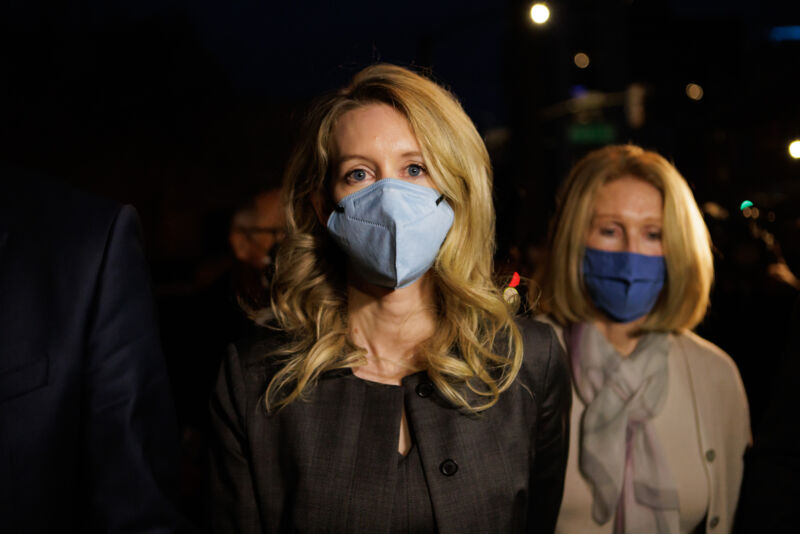
Dai Sugano/MediaNews Group/The Mercury News
When jurors deliberated the case of Elizabeth Holmes, the founder of failed medical diagnostic startup Theranos, two pieces of evidence helped them convict her of fraud: a faked pharmaceutical company report and inflated financial projections.
Holmes was convicted earlier this week of one count of conspiracy to commit wire fraud and three counts of wire fraud, all involving investors. She was acquitted of defrauding patients, and the jury deadlocked on charges that she defrauded three other investors. The four women and eight men who served as jurors reached their decision after more than 50 hours of deliberations.
On the four guilty counts, jurors found the evidence clearly convincing, with one juror describing two pieces as “smoking guns” in an interview with The Wall Street Journal. One piece was a Theranos-authored report that Holmes gave to investors; it had a Pfizer logo at the top of every page, making it look like the pharmaceutical company had either written or approved its findings. The second was a set of financial projections that Holmes shared with investors, including Lakeshore Capital Management, the DeVos family office.
“There were just so many falsehoods on that sheet of paper,” said Susanna Stefanek, an editorial manager at Apple who was known at the trial as Juror No. 8. “She was trying to make this thing look better than it was, and that was just clearly a deceptive act.”
Rosy projections
The projections showed that Theranos would bring in $140 million in revenue in 2014 and lose just $3 million. For 2015, the company forecast $990 million in revenue with $230 million in profit. But the most damning piece for the jury was the claim that Theranos would bring in $40 million in revenue from pharmaceutical companies in 2014 despite a lack of contracts.
On the same document, Lisa Peterson, who was overseeing the Theranos investment for the DeVos family, mentioned “900 stores,” which she told the court referred to Holmes’ claim that Theranos would have its devices in 900 Walgreens stores. For Stefanek and other jurors, that figure was damning. They heard in testimony that months before Holmes gave the document to Peterson, Walgreens had drastically scaled back the rollout to 200 stores. In the end, Theranos testing was introduced in just 41 stores.
Hyperbole isn’t unusual in Silicon Valley, Stefanek said, but “when it got to providing those hard-money figures that were completely bogus, that was when I had to say no.”
Jurors had a harder time finding Holmes guilty of allegations that she defrauded patients. Yes, the lab was very poorly run, they agreed, but they didn’t think the prosecution had presented enough evidence to convince them that Holmes had intentionally marketed problematic tests to patients.
“If all we’d had to prove was that she knew there might be problems in the lab and that might end up harming patients, that would be one thing,” Stefanek said. But she and others felt the bar was higher for the charges. The foreman, who didn’t want to be identified, said he initially supported a guilty verdict for defrauding patients but changed his mind after the jury debated the matter.
Witness credibility
In reviewing the testimony heard in court, the jurors rated each witnesses’ credibility on a scale of one to four stars, with four being the most credible. Most received top marks, including Theranos patients, doctors, former defense secretary Jim Mattis, and those who had worked for Walgreens and Safeway.
One key witness, Erika Cheung, was docked a star for appearing to be “invested in a certain outcome,” Stefanek said. Cheung had worked in Theranos’ research and development lab and its clinical lab. She ended up quitting after seven months and filed a whistleblower report with the Centers for Medicare and Medicaid Services, claiming that the company routinely cherry-picked data.
Cheung responded, telling the WSJ, “I respect the jury’s effort, time, and energy” but noted that her credibility ranking with the jury showed “an indication that there is still stigmatization against whistleblowers.” The trial backed up her allegations, Cheung said, and added that “a life goal of mine was never to play a role in sending someone to prison.”
The lowest-ranked witness was Holmes herself. Jurors generally believed Holmes’ allegations of abuse by her ex-boyfriend and Theranos executive Ramesh “Sunny” Balwani. But they didn’t think it played a role in the fraud committed against investors.
With Holmes’ testimony, the jury felt “there was a certain amount of cynicism that it was a sympathy ploy,” Stefanek said.
